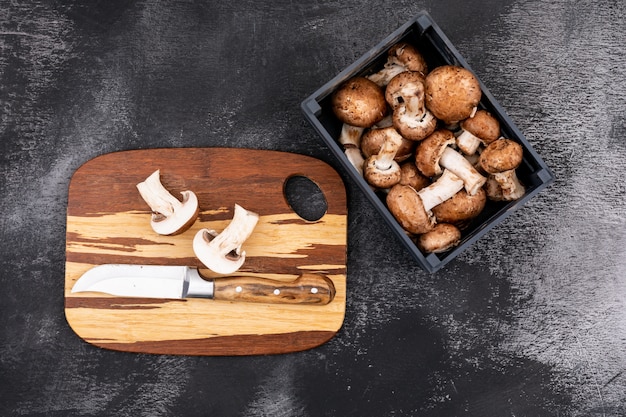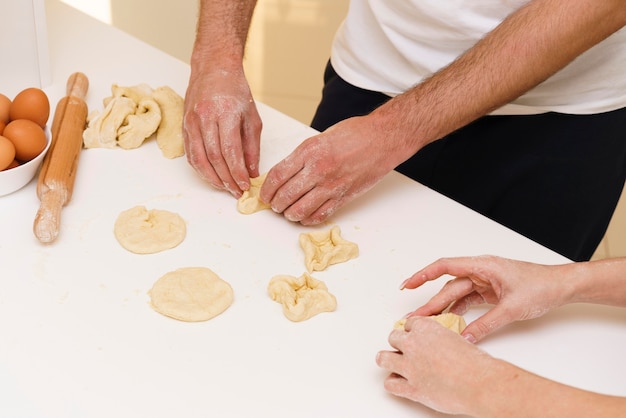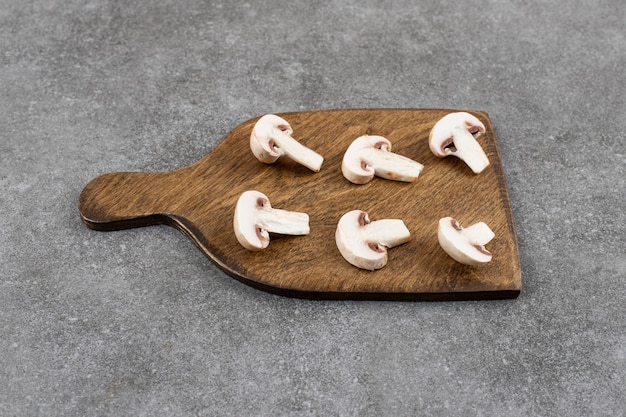The scent of damp earth and fallen leaves, the thrill of a hidden treasure, and the promise of a delicious meal – these are the things that draw me to the woods each autumn in pursuit of chanterelles. These bright yellow, trumpet-shaped mushrooms are a true gift from nature, offering a delicate, slightly fruity flavour that's simply irresistible. But beyond the joy of foraging, lies the question of what to do with these culinary treasures once you've gathered them. So, allow me to share some of my favourite chanterelle recipes, techniques, and insights, hopefully inspiring you to embark on your own chanterelle adventure.
(Part 1) The Enchanting World of Foraging

The act of foraging for chanterelles is more than just gathering ingredients; it's a sensory experience, a connection to the natural world. The crisp autumn air, the rustling of leaves underfoot, and the hushed quiet of the forest create a tranquil backdrop to the thrill of the hunt. The anticipation builds as you scan the mossy ground, searching for the telltale signs of a chanterelle patch. Then, the moment of discovery – a cluster of vibrant yellow trumpets emerging from the undergrowth. It's a moment that reminds you of the beauty and bounty that nature offers.
Navigating the Forest Floor: A Beginner's Guide to Identifying Chanterelles
Before you venture into the woods, it's essential to equip yourself with the knowledge to identify chanterelles accurately. Mistaking them for other mushrooms, some of which can be poisonous, can have serious consequences. Thankfully, chanterelles have a few distinctive characteristics that help distinguish them from imposters.
- Shape: Chanterelles resemble trumpets or funnels, with a smooth, slightly wavy cap that blends seamlessly into the stem. Unlike other mushrooms, they lack gills on the underside of the cap, instead featuring a smooth, wrinkled surface called "false gills."
- Color: Chanterelles sport a vibrant yellow hue, ranging from pale yellow to a deep orange-yellow.
- Smell: A sweet, fruity aroma, often described as apricot-like, is another distinguishing feature.
- Habitat: They favour damp, mossy woodlands, particularly under beech, oak, and pine trees.
- Seasonality: Their peak season typically runs from late summer to early autumn.
However, even with these clues, it's crucial to approach identification with caution. If you're ever unsure, it's best to consult with a knowledgeable expert or simply leave the mushroom undisturbed. A good field guide dedicated to edible fungi or joining a local foraging group can be immensely helpful for learning proper identification and safe foraging practices.
Foraging Tips: From the Woods to Your Kitchen
Once you've confidently identified a chanterelle patch, it's time to gather your harvest. Here's a set of tips to ensure a successful and sustainable foraging experience:
- Respect the Environment: Leave no trace. Avoid disturbing the forest floor, and always respect wildlife and their habitats.
- Harvest Responsibly: Take only what you need, leaving some mushrooms behind to ensure the population thrives.
- Choose a Basket: A basket allows air to circulate around the mushrooms, preventing them from getting squashed or sweating, which can affect their flavour.
- Clean as You Go: Brush off any debris or dirt on your mushrooms right away, saving you time later.
(Part 2) Preparing for Culinary Success

Bringing home a basketful of chanterelles is a joyous occasion, but it's not the end of the journey. Proper preparation plays a crucial role in unlocking their flavour and texture, ensuring a delightful culinary experience.
Cleaning with Care
Unlike many other mushrooms, chanterelles don't need a thorough washing. Their delicate flesh can soak up water, turning them soggy and diminishing their flavour. Instead, gently remove any debris with a damp cloth or a small brush. You can also use a small knife to trim off any tough bits from the stem. Remember, the key is to clean them as gently as possible, preserving their natural texture.
Slicing and Dicing: Adapting to Your Recipe
The way you slice your chanterelles will depend on how you plan to cook them. For stews and soups, I prefer to cut them into larger chunks, allowing their flavour to infuse the broth. For sautéing or stir-fries, I opt for thinner slices, which cook more quickly and release their aromatic oils. And when using them in pasta dishes or risottos, smaller dice are the way to go, allowing them to integrate seamlessly into the dish.
Preserving the Goodness: Storage Strategies for Chanterelles
Freshly picked chanterelles are best enjoyed as soon as possible, but sometimes you need to store them for a short period. Here are a few tips for preserving their freshness:
- Refrigeration: Wrap them loosely in paper towels and store them in the refrigerator for up to 3 days.
- Freezing: For longer storage, spread them out on a baking sheet and freeze until solid. Once frozen, transfer them to freezer bags or containers for long-term preservation. However, be aware that freezing can slightly alter their texture.
(Part 3) Unlocking Flavor: Chanterelle Recipes for Every Occasion

Now, for the most exciting part – the culinary transformation of these wild mushrooms. Their unique flavour and versatility make them suitable for a wide range of dishes, from simple preparations that highlight their natural essence to more complex creations.
1. Sautéed Chanterelles: A Simple Classic
This dish is the epitome of simplicity, letting the chanterelles shine in their natural glory. The fragrant combination of garlic and thyme complements their earthy flavour, creating a symphony of taste.
Ingredients:
- 1 pound fresh chanterelles, cleaned and sliced
- 2 tablespoons olive oil
- 2 cloves garlic, minced
- 1 tablespoon fresh thyme leaves
- Salt and pepper to taste
Instructions:
- Heat the olive oil in a large skillet over medium heat.
- Add the chanterelles and cook, stirring occasionally, until they are golden brown and tender, about 5-7 minutes.
- Add the garlic and thyme, and cook for another minute, until fragrant.
- Season with salt and pepper to taste.
- Serve immediately over pasta, polenta, or rice, or enjoy as a side dish.
2. Creamy Chanterelle Pasta: A Luxurious Treat
For a luxurious pasta experience, this dish delivers rich, creamy indulgence. The chanterelles are cooked with white wine and cream, creating a luscious sauce that coats the pasta perfectly. A sprinkle of Parmesan cheese adds an extra layer of flavour and decadence.
Ingredients:
- 1 pound fresh chanterelles, cleaned and sliced
- 2 tablespoons olive oil
- 1/2 cup dry white wine
- 1 cup heavy cream
- 1/4 cup grated Parmesan cheese
- 1/2 teaspoon salt
- 1/4 teaspoon black pepper
- 1 pound pasta, cooked according to package directions
Instructions:
- Heat the olive oil in a large skillet over medium heat.
- Add the chanterelles and cook, stirring occasionally, until they are golden brown and tender, about 5-7 minutes.
- Pour in the white wine and cook until it has reduced by half.
- Stir in the heavy cream and bring to a simmer.
- Reduce the heat to low and cook for another 5 minutes, or until the sauce has thickened slightly.
- Stir in the Parmesan cheese, salt, and pepper.
- Add the cooked pasta to the sauce and toss to coat.
- Serve immediately.
3. Chanterelle and Leek Tart: A Festive Feast
This tart is a beautiful and elegant dish that's perfect for a special occasion. The earthy flavours of the chanterelles and leeks are perfectly balanced by the flaky pastry crust and the creamy filling, creating a symphony of textures and tastes.
Ingredients:
- 1 sheet of puff pastry, thawed
- 1 tablespoon olive oil
- 1 large leek, thinly sliced
- 1 pound fresh chanterelles, cleaned and sliced
- 1/2 cup heavy cream
- 2 large eggs
- 1/4 cup grated Parmesan cheese
- Salt and pepper to taste
Instructions:
- Preheat oven to 400 degrees F (200 degrees C).
- Line a 9-inch tart pan with the puff pastry. Prick the bottom with a fork.
- Heat the olive oil in a large skillet over medium heat.
- Add the leeks and cook, stirring occasionally, until softened, about 5 minutes.
- Add the chanterelles and cook, stirring occasionally, until they are golden brown and tender, about 5-7 minutes.
- In a medium bowl, whisk together the heavy cream, eggs, Parmesan cheese, salt, and pepper.
- Pour the cream mixture over the chanterelle and leek mixture in the tart pan.
- Bake for 25-30 minutes, or until the pastry is golden brown and the filling is set.
- Let cool slightly before serving.
(Part 4) Beyond the Basics: Exploring More Complex Chanterelle Dishes
While the recipes above offer a great foundation, your culinary adventures with chanterelles can go far beyond the simple and familiar. Embrace the challenge of more complex dishes, allowing their unique flavour to shine in unexpected combinations.
1. Chanterelle and wild rice soup: A Hearty Comfort
For a soul-warming soup that's both hearty and elegant, consider this combination. Wild rice adds a nutty flavour, complementing the earthy chanterelles, while the broth provides a comforting base. This soup is perfect for chilly evenings or a cozy weekend brunch.
2. Chanterelle and Goat Cheese Tartlets: A Festive Bite
These bite-sized treats are perfect for a party or a special occasion. The creamy goat cheese, with its tangy sharpness, complements the earthy chanterelles beautifully, creating a delightful balance of flavours. The tartlets can be served as an appetizer or a light lunch.
3. Chanterelle and Prosciutto Risotto: A Luxurious Classic
A classic risotto gets a luxurious upgrade with the addition of chanterelles and salty prosciutto. The combination of earthy and salty flavours, coupled with the creamy texture of risotto, creates a truly decadent dish that's perfect for a romantic dinner or a special celebration.
4. Chanterelle and Thyme Stuffed chicken breast: A Flavorful Main Course
Elevate your chicken dinner with a flavorful stuffing that adds a touch of sophistication. The earthy chanterelles and aromatic thyme create a harmonious flavour profile that's sure to impress. This dish is perfect for a casual weeknight meal or a more formal dinner party.
(Part 5) Seasonality and Preservation: Enjoying Chanterelles All Year Round
Like many wild mushrooms, chanterelles have a limited season, typically appearing in late summer and early autumn. To extend their culinary magic beyond their peak season, consider these preservation methods:
1. Freezing: The Simple and Convenient Method
Freezing is the easiest way to preserve chanterelles. Simply clean and slice them, then spread them out on a baking sheet and freeze until solid. Once frozen, transfer them to freezer bags or containers for long-term storage. While freezing can slightly alter their texture, it's a convenient method for preserving their flavour and aroma.
2. Drying: Concentrating Flavor and Aroma
Drying is another effective method that concentrates the flavour and aroma of chanterelles, while extending their shelf life. You can use a food dehydrator or an oven set on a low temperature. Once dried, they can be stored in airtight containers for several months. To rehydrate dried chanterelles, simply soak them in hot water before using them in recipes.
3. Pickling: A Tangy and Unique Twist
Pickling is a fun way to preserve chanterelles and add a unique flavour twist. The vinegar and spices create a tangy, slightly sweet flavour that's perfect for salads, sandwiches, or as a side dish. Pickled chanterelles offer a surprising and delicious way to enjoy these wild mushrooms.
(Part 6) Exploring Substitutes: Expanding Your Culinary Options
Not everyone has access to chanterelles, especially those outside of their prime season. If you're looking for a substitute that can capture some of their essence, consider these options:
1. Shiitake Mushrooms: A Rich, Earthy Alternative
Shiitake mushrooms offer a rich, umami flavour that's similar to chanterelles. They have a firmer texture, so you may need to cook them a little longer, but they can be used in many chanterelle recipes, adding a distinct earthy note.
2. cremini mushrooms: A Versatile and Widely Available Choice
Cremini mushrooms have a milder flavour than shiitakes but still offer a good earthy base. They're readily available and can be used in most chanterelle recipes, providing a more subtle yet satisfying flavour.
3. Oyster Mushrooms: Delicate Flavor and Chewy Texture
Oyster mushrooms have a delicate flavour and a slightly chewy texture. They work well in stir-fries and soups, adding a unique dimension to the dish. While their flavour is different from chanterelles, they can add a delightful complexity to your recipes.
(Part 7) Chanterelle Recipes: Pushing the Boundaries of Culinary Creativity
Don't be afraid to get creative with your chanterelle recipes! The beauty of these wild mushrooms lies in their versatility, allowing them to blend seamlessly into a wide range of cuisines and culinary styles. Here are a few ideas that go beyond the classic:
1. Chanterelle and Black Truffle Pizza: A Luxurious Delight
For a truly decadent pizza experience, top your dough with chanterelles, thinly sliced black truffles, and a drizzle of truffle oil. This combination of earthy flavours and luxurious aromas will transport your taste buds to another dimension. It's a perfect option for a special occasion or a romantic dinner.
2. Chanterelle and Parmesan Arancini: Crispy and Cheesy Bites
These crispy, cheesy bites are perfect for an appetizer or a snack. The earthy flavour of the chanterelles complements the richness of the Parmesan cheese perfectly, while the crispy outer crust provides a delightful contrast in texture. Arancini are sure to be a hit at any gathering.
3. Chanterelle and Prosciutto Salad: A Light and Elegant Option
A simple yet elegant salad with chanterelles, thinly sliced prosciutto, arugula, and a light vinaigrette is perfect for a summer lunch or dinner. The combination of earthy, salty, and peppery flavours creates a refreshing and satisfying dish that's both light and satisfying.
4. Chanterelle and Gruyère Quiche: A Rich and Savoury Treat
This quiche is a delightful combination of earthy flavours and creamy texture. The chanterelles and Gruyère cheese create a rich and satisfying filling, while the flaky crust provides a comforting base. Quiche is a versatile dish that can be enjoyed for brunch, lunch, or dinner.
(Part 8) Chanterelle Recipes: A Culinary Adventure Awaits
Foraging for chanterelles is an adventure that I highly recommend. It's not only a fun way to spend time in nature but also a chance to bring a unique and delicious ingredient to your kitchen table. Whether you're a seasoned forager or just starting out, there's a world of culinary possibilities waiting to be explored. So, grab your basket, head out to the woods, and let your imagination run wild. Your taste buds will thank you!
FAQs
1. How do I know if a chanterelle is safe to eat?
Identifying edible mushrooms can be tricky. Always do your research and consult reliable sources like field guides or experienced foragers. If you're unsure, it's best to err on the side of caution and leave the mushroom alone. Remember, your safety is paramount.
2. Can I wash chanterelles?
It's best to avoid washing chanterelles under running water, as they can absorb water and become soggy. Instead, use a damp cloth or a brush to remove any debris. Gentle cleaning is key to preserving their flavour and texture.
3. How long do chanterelles last in the fridge?
Fresh chanterelles can be stored in the refrigerator for up to 3 days when wrapped loosely in paper towels. However, for optimal flavour and texture, it's best to use them as soon as possible.
4. Can I freeze chanterelles?
Yes, you can freeze chanterelles for longer storage. Spread them out on a baking sheet and freeze until solid, then transfer them to freezer bags or containers. However, frozen chanterelles may lose some of their texture and flavour, so it's best to use them in dishes where texture is less critical.
5. What are some good substitutes for chanterelles in recipes?
If chanterelles aren't available, you can substitute them with other mushrooms like shiitakes, cremini, or oyster mushrooms. However, keep in mind that their flavour and texture may vary slightly. Shiitakes offer a rich, earthy flavour, creminis provide a milder earthy taste, and oyster mushrooms have a delicate flavour and chewy texture.
Everyone is watching

How to Cook Frozen Lobster Tails Perfectly: A Step-by-Step Guide
RecipesLobster. Just the word conjures up images of lavish meals, special occasions, and a taste of luxury. But let's...

Pigs in a Blanket Cooking Time: How Long to Bake for Perfect Results
RecipesAh, pigs in a blanket. Just the name conjures up images of those delightful little parcels of crispy pastry en...

Pork Fillet Cooking Time: How Long to Cook It Perfectly
RecipesPork fillet, or tenderloin as it's sometimes called, is a real favourite in our house. It's so versatile, and...

The Ultimate Guide to Tender, Juicy Pulled Pork
RecipesRight, let's talk pulled pork. It's one of those dishes that just screams "comfort food," doesn't it? I mean...

The Ultimate Guide to Cooking Delicious Frankfurters
RecipesLet's face it, we all love a good frankfurter. It's a classic, simple, and always satisfying. But let's be rea...
